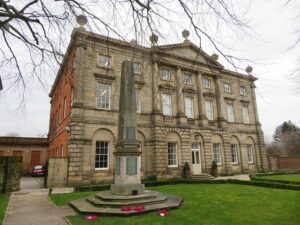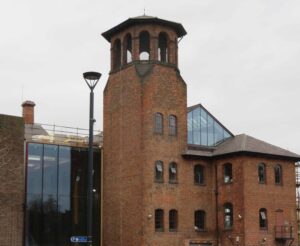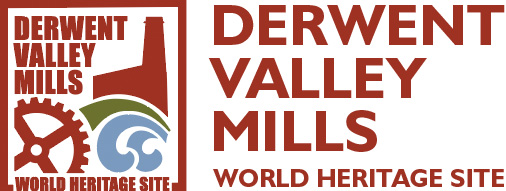Derby and Little Chester Walks

Discover Derby and Little Chester
Derby and Little Chester Heritage Walks
Two different options for a walk starting in Chester Green set out below, or available to download as a pdf here: Derby and Little Chester Heritage Walks Leaflet
Welcome to Derby, Southern Gateway to the Derwent Valley Mills World Heritage Site. The remains of the city’s Roman, Saxon and industrial past can still be seen.
From Darley Abbey, the River Derwent flows between two Conservation Areas, Strutt’s Park and Little Chester, before passing Derby’s Museum of Making. This occupies the site of a silk spinning mill built by the Lombe brothers in the early eighteenth century.
Derby developed as a silk and cotton spinning centre from this time. The pioneering Strutt family owned mills here as well as at Milford and Belper. William Strutt lived at St Helen’s House and the houses of Strutt’s Park are built over its gardens. There were also lace and elastic web weaving mills.
Derby was renowned for its engineers. Along this stretch of the river, the Fox Brothers made machine tools, Haslam built refrigeration plants for ships and Handyside manufactured castings, bridges, towers, piers etc, which were transported across the world. Derby Crown China’s first factory was also close by.
The importance of Derby and its historic industrial neighbours at Cromford, Belper, Milford and Darley Abbey was reflected by inscription on the UNESCO World Heritage List in 2001. This leaflet offers a short circular walk, with optional extensions, visiting some of the most significant historic sites. During your walk you will see more information on interpretation boards.
Walk Start The walk begins at the car park on City Road (DE1 3RR). This lies over a former Great Northern Railway (GNR) embankment. From here it is only a few paces, over the flood defence wall, to the River Derwent. A former GNR bridge, constructed in 1877 by Andrew Handyside, spans the river. As you cross the bridge, look upstream towards Darley Park and the boathouses, before turning left down a short flight of steps to the river bank or follow the more accessible surfaced path round to the right to pass under the bridge. Here you will find an interpretation board about the bridge and surrounding area.
Proceed along the footpath towards Derby, which follows the route 
of a spur branch of the railway, and fork right towards the 12 storey Rivermead House. Keep the entrance on your right, then turn right and look for a steep cobbled street. At the bottom is St. Alkmund’s Well (number 1 on map), dedicated to a Saxon saint.
You can either retrace your steps and continue along the riverside path past the Furnace Inn to St Mary’s Bridge where you will find an interpretation board, or to view St. Helen’s House, one time home of William Strutt, walk up Well Street, which is steep and cobbled (Option A on the map). At the top, turn left along North Parade. This is a Grade 2 listed terrace (1826). At the end of the row, the former school playground was once a burial ground attached to the now demolished St. Alkmund’s Church. Walk on until the way ahead is blocked by the Inner Ring Road. Turn right and pass St. Mary’s Catholic Church, designed by Augustus Pugin and opened in 1839. Walk along Bridge Gate, passing an early 18th century building, once used as a convent, until you reach a main road. Here you will find Grade 1 listed St. Helen’s House (number 2 on map). Built to designs by Derby architect Joseph Pickford in 1767, William Strutt (who developed pioneering skyscraper technology) lived here from 1806-1830.
demolished St. Alkmund’s Church. Walk on until the way ahead is blocked by the Inner Ring Road. Turn right and pass St. Mary’s Catholic Church, designed by Augustus Pugin and opened in 1839. Walk along Bridge Gate, passing an early 18th century building, once used as a convent, until you reach a main road. Here you will find Grade 1 listed St. Helen’s House (number 2 on map). Built to designs by Derby architect Joseph Pickford in 1767, William Strutt (who developed pioneering skyscraper technology) lived here from 1806-1830.
Retrace your steps but this time, follow the path running downhill  alongside the ring road to the river. At the bottom, you’ll see the 16th century tower of Derby Cathedral to the right. Turn left onto Sowter Road and when you reach the flood gates, cross the road to the bridge. By the river, you will find an interpretation board about the history of the bridge and ancient bridge chapel. (The Museum of Making in the Silk Mill can be visited from here – number 3 on map).
alongside the ring road to the river. At the bottom, you’ll see the 16th century tower of Derby Cathedral to the right. Turn left onto Sowter Road and when you reach the flood gates, cross the road to the bridge. By the river, you will find an interpretation board about the history of the bridge and ancient bridge chapel. (The Museum of Making in the Silk Mill can be visited from here – number 3 on map).
Route Continued: Cross over the bridge and turn left past the former Waterside Public House. Cross City Road and continue along Mansfield Road. On your right are buildings which were once part of St. Mary’s Railway Goods Wharf, serving the Midland Railway. These listed buildings, including the cantilevered loading bay, have been converted to other uses. Pass The Duke of Clarence to St. Paul’s Church (1850) and Chester Green. Pause to admire its setting and the architecture of the houses on St. Paul’s Road along the edge of the Chester Green. Haslam built these for his workforce (c.1890). At certain times you can enter the church to visit the Little Chester Heritage Centre.
From here you can walk along St. Paul’s Road in front of the houses to the facade of Sir Alfred Seale Haslam’s Union Foundry and the associated building opposite. These are fine examples of Victorian brickwork and industrial architecture. Walk past the façade and before turning into the ‘Start’ Car Park, you will find, within the greenery, an interpretation board a few strides further on, about a
Roman building found in 1924 during the construction of the nearby cricket pavilion.
Alternatively (Option B on the map), to view the Roman site of Derventio, from St. Paul’s Church follow the path through the Green with Haslam’s Union Foundry in the distance on your left. At the far side you should be able to see a large Interpretation Board relating the history of the Green. Turn left along Chester Green Road and right into Marcus Street. At the end of Marcus Street you will find a Roman well and base stones of a timber framed Roman building, with an interpretation board. Just before reaching the well, a footpath to your left follows the line of the former Great Northern Railway back to the ‘Start’ Car Park.
The Silk Mill, Derby’s Museum of Making, is a short distance downstream. It can be reached by following a path under the bridge and along the riverside. Alternatively, if the path is inaccessible, follow Sowter Road under the Ring Road Bridge and follow the signs.


